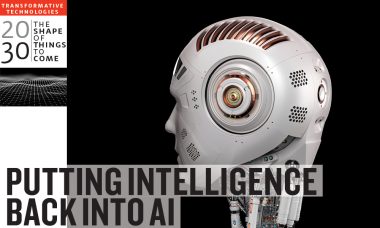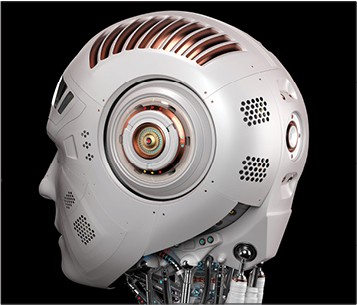Putting Intelligence Back into AI

Today’s version of artificial intelligence is at risk of undercutting the power of knowledge.To free this important technology, here are 10 recommendations that will enable AI in manufacturing operations to prosper. By Jim Davis
Artificial intelligence and machine learning have taken on silver bullet status for advanced manufacturing with entire countries investing in programs and competing for global leadership. This resurgence in interest has been propelled over the past 10 years or so with significant and publicly prominent advances in particular AI areas, notably game playing, robotics, self-driving cars, speech recognition, facial recognition, and many decision systems we experience as consumers of products and services. Of course, the other major factor is today’s access to data management and computational capabilities that simply did not exist a decade ago.
Unprecedented capacity to collect, work with, and manage massive amounts of data are now commonplace with network-based cloud services; graphical processor units, not just CPUs; and, more recently, computationally rich edge-cloud capabilities. Altogether, breakthrough data science, IT infrastructure and methods now exist for learning systems applied to amazingly large data sets. These include deep convolutional neural networks, a host of data clustering approaches, reinforcement learning, recurrent neural networks, and statistical learning.
A particularly important class of AI/ML applications in manufacturing involves measuring the state of an operation, analyzing it, and determining automated and human-centered actions to be taken at the right time. For those of us involved with the early work on this class of AI/ML applications in the 1980’s, we know all too well why the technology did not take off and all but disappeared. We were working with primitive graphics, experimental AI machines, and early object-oriented and AI languages. The web did not yet exist, ERP systems had not come into vogue, and cloud services had not been thought about. On the plus side, cyber security was not yet an issue.
More importantly, manufacturing’s prevailing coding mindset was asset- and operations-oriented. Object-oriented programming did not get any traction (and still has not) as a concept for structuring process knowledge for better usability. Digitization was occurring but digitalization and the data revolution had not begun. The industry just wasn’t ready conceptually, technically, or with adequate infrastructure.
For engineering applications, the term AI literally became a negative in the 1990’s. Those of us who continued in the field disguised our work with terms like Data Analysis and Interpretation and Intelligent Systems. Keep in mind that Smart Manufacturing did not enter the vocabulary of interest until around 2005. Industrie 4.0 in Germany started about the same time under the heading of Smart Factory. What we did do in the 1980’s was learn a lot about the role of domain knowledge and how to use and embed knowledge with ML solutions.
What Has Been Lost
Fast forward to today, the global resurgence in AI/ML, largely since 2005, is amazing to observe, having advocated for its value for so many years. Furthermore, it is remarkable just how far the processors, tools, platforms, infrastructure and foundational data science have progressed in such a short time in comparison to how constrained we were in the 80’s and 90’s. Notably, this resurgence has produced a large number of software tools and platforms with the critical IT and data science underpinnings that can respond computationally to today’s massive increases in data that are in amounts that far surpass human capability to assimilate.
In an era of IIoT, it is quite possible to quickly and almost randomly apply tools to produce apparently reasonable results with huge data sets. When the covers are peeled back, however, we are seeing AI/ML solutions that are constructed without the needed analysis of the data or the alignment of data with objective. For example, it is easy to construct solutions with the faulty assumptions that there are enough right data, the data contain every scenario of interest, and the algorithm will figure it out. All too often, solutions are re-learning the physics of an operation or are erroneously making decisions keying off noise or overly dominant variables.

Without a thorough grounding in understandablility, AI/ML
approaches will be biased and untrusted, and more likely to fail.
Put more generally, today’s version of AI has undercut the power of knowledge and is over relying on the data tools and data science. This is a trap that has long proved faulty. Furthermore, AI/ML solutions are so focused on the ML aspect that the capacity for cognitive interpretation, explanation, and understandability, which are AI needs and strengths, are essentially missing in action. The reality is that without a thorough grounding in understandability and explainability, AI/ML applications in manufacturing operations are more likely to be biased, brittle, unpredictable, untrusted, difficult to sustain, and much more likely to fail as a result.
In addition, apparently lost is just how much the engineering of an AI/ML solution is a human-centered process, albeit significantly enabled by technology. The industry surely needs to be engaging in the low-hanging fruit opportunities, while it also needs to be wary of a false sense of readiness given the progress with new data capabilities.
Interest Spans Many Levels
In the space of manufacturing execution and control, applications (measuring state, analyzing, and taking action), there is interest in AI applications spanning all operational levels – device, process, line operation, and supply chain. It is important to consider cognition, explanation and understandability, the need for embedded knowledge, and the requirement to select and contextualize data for objective. When characterized from these perspectives, manufacturing AI application interests include discover, monitor, diagnose, predict, optimize, self-interrogate, customize, and visualize (interoperate with humans). Individually and in combination, all are for the larger purposes of controlling and managing an operation to economic, social, consumption, environmental, and safety objectives that define competitiveness.
In looking to 2030, let’s dust off some of the old lessons learned from the 80’s and 90’s. These characterize aspects to watch out for now and that need attention and development for AI/ML solutions in manufacturing operations to prosper.
- An AI/ML solution is doomed to failure if the assumption is that the algorithm will figure it out. Also, if you are confused about the problem definition, the system will be too.
- Cognition, interpretation, understandability, and applied knowledge are key strengths and requirements for AI solutions. Explainable models and models that can explain go hand-in-hand.
- Use the full span of modeling to include not only ML, first principles, and math modeling but also qualitative modeling and interpretation modeling. Explainable models are hybrid.
- Be careful not to formulate an AI/ML solution to take on too many decisions with a single method. It won’t be able to do it and you won’t be able to explain it.
- Formulate AI solutions to align with how operational complexity typically emanates as interactions among simpler elements. Causation is as important as correlation and patterns.
- AI/ML algorithms that work well for math modeling, such as neural networks and statistical modeling, do not necessarily work well for interpretation. The reverse is true for interpretation modeling.
- State measurements in time-varying systems involve time-windows applied over time. Interpretation and the role of time need to be engineered carefully with the domain in mind.
- No ML model ever works without enough of the right data, no matter the volume. It is not possible to circumvent the knowledge and lift needed to contextualize data for an objective.
- Build infrastructure, technology, and practice for nurturing an AI system for sustainability, learning, unlearning, and continuous improvement. An AI system is a human-centered engineering process.
- People trust people first, not machines, but also easily over rely on algorithms. Don’t underestimate, be prepared, and engineer AI/ML systems for explaining ethical considerations.

Looking ahead, the great opportunity is to engineer sustainable AI applications that produce understandable and explainable results.
The Limits of Math
We engineers value our mathematics and there is a very rich arsenal of tools and platforms for processing numeric data and doing mathematical modeling1. Advances in ML have significantly added to this arsenal. As valuable as the math-based approaches are, they have their limits as higher level considerations and/or greater amounts and breadths of data become of interest. Examples include reasoning about cause and effect, time and workflow, conditional considerations, and combinations of systems. There is also the need to explain predictions, and interface with humans.
In manufacturing, these are problems where there often is not enough of the right data and where interpretation and explanation are not only important, but also take advantage of useful knowledge modeling strategies in the form of decomposition, causality, inference, patterns, clusters, and workflow. Also, physics-based models in qualitative forms can be rigorous and as useful as math-based models.
The good news is that after all these years, AI/ML is poised for success in manufacturing operations. That success will depend on the amount of right data and the right models that address the application of knowledge. CESMII, the Clean Energy Smart Manufacturing Innovation Institute2 has, for example, focused considerable effort on infrastructure for managing contextualized data and the development of reusable application profiles which capture critical forms of knowledge and connects them to the contextualized data for operational use.
Looking ahead to 2030, the great opportunity for AI in manufacturing is to be able to engineer sustainable AI applications that produce understandable and explainable results and that can be trusted as a result. New data science-based platforms, tools, and methods are in sight that bring today’s extensive ML capabilities together with the ability to more easily contextualize data to objective, reuse embedded knowledge, and incorporate a far richer array of modeling strategies. M
1 Consider univariate, probabilistic and multivariate categories of single scale, multiscale, projection-based, kernel-based, partition-based linear and non-linear methods.
2 CESMII is one of the fifteen Manufacturing USA Institutes and is among the five that are sponsored by DOE.